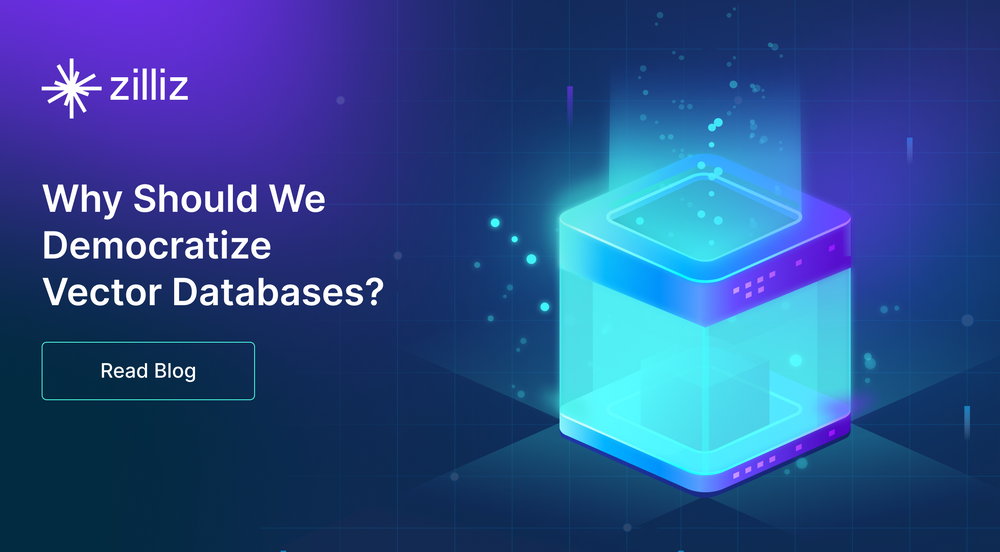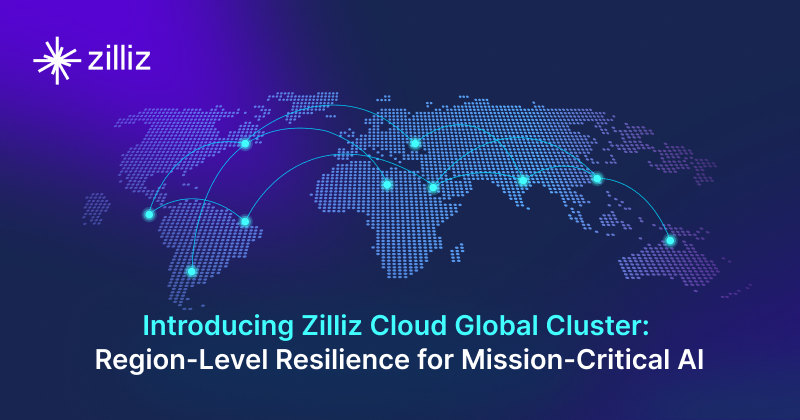Breaking Barriers: Democratizing Access to Vector Databases for All

This post was originally published on The New Stack and is reposted here with permission.
Large language models (LLMs) and AI-related technologies are on everyone’s lips. Vector databases, the critical infrastructure for LLMs and AI applications, have gained widespread attention from a broader user base, expanding from algorithm engineers to include application and backend developers.
Let’s take a look at the benefits of vector databases, why democratizing them is crucial, and how to make them accessible to everyone. We also offer a benchmark tool to help you choose the most suitable vector database for your projects.
What is a vector database?
Unlike traditional relational or NoSQL databases that store and organize data in structured formats, a vector database is purpose-built to store and manage unstructured data, such as images, audio, videos, and text in numeric representations called embeddings.
Vector databases are crucial for performing similarity searches using the approximate nearest neighbor (ANN) algorithm. This algorithm enables finding the closest point to a given point within a given set, making vector databases valuable for various use cases, including recommender systems, anomaly detection, and question-and-answer systems.
Vector databases vs. traditional vector search techniques
Vector searching is not a new concept. Before specialized vector databases emerged, various tech stacks were available for conducting vector searches. Examples include vector libraries like Facebook FAISS, Spotify Annoy, Google ScaNN, and vector search extensions like pgvector. Large companies like Google, Microsoft, and Netflix have used these technologies for tasks such as recommendation systems.
Although traditional vector searching techniques have basic features such as storing, indexing, and searching for vectors, they have limitations. For example, when you have to deal with a large dataset with millions or billions of high-dimensional vectors and, at the same time, you require quick responses and high recall, traditional retrieval systems can hardly meet your expectations. In this case, a purpose-built vector database is necessary.
Compared to traditional vector search stacks, purpose-built vector databases offer improved and various features, including:
Full CRUD (create, read, update, and delete) support
Scalar and vector filtering
Support for SDKs of multiple programming languages and restful APIs
Enterprise-level capabilities such as high availability and scalability, resource groups, role-based access control (RBAC), and production deployments
And more.
Vector databases have become increasingly popular and essential due to the rise of ChatGPT and the growing interest in generative AI and LLMs. Consequently, more developers and organizations are seeking access to them.
Why are vector databases essential in the era of AI?
Vector databases have become indispensable for LLMs and related AI tech stacks. They serve as the LLMs’ long-term memory, expanding LLMs’ knowledge and retrieval capabilities and enabling more accurate answers related to your data and business.
ChatGPT might generate hallucinatory responses due to its limited or outdated pretraining offline knowledge. Moreover, ChatGPT’s token limit makes it difficult for users to provide too much context. To solve this issue, the CVP stack (ChatGPT/LLM + a vector database + prompt as code) is gaining popularity, using a vector database to store domain-specific or proprietary facts outside the LLM for retrieval. This expansion leads to more accurate results.
Popular AI stacks such as LlamaIndex, AutoGPT, and LangChain are examples that leverage vector databases for long-term vector storage and/or LLM knowledge augmentation.
Democratizing vector databases for all
Vector databases are crucial in the current AI revolution. But, only some have equal access to this technology due to various barriers, such as proprietary technology, complex architecture and deployment, high costs for individual developers or small teams, and poor user experience. Therefore, it is vital to democratize vector databases to make progress, with pioneers and providers taking the lead.
Making vector databases accessible to everyone cannot happen overnight. It’s unrealistic to expect every database to store and search for vectors immediately or those vector database providers to suddenly open up their technologies to all. However, there are some valuable tips for improved vector database democratization.
Evangelizing vector database knowledge, expertise, and technologies
To effectively work with vector databases, developers should become familiar with this technology's benefits, ecosystems, use cases, and limitations. So, spreading awareness about vector databases' knowledge, expertise, and technologies is vital through various content, including academic papers, blog posts, tutorials, and speeches. At Zilliz, we've built a content library covering everything from the basics of vector searching technologies (like unstructured data and Hierarchical Navigable Small Worlds) to popular AI stacks (like LangChain, LlamaIndex, and AutoGPT). We also offer various offline events and webinars that are valuable resources for developers interested in this vector stack.
Open the source code to all developers
Open source is a crucial way to promote the democratization of vector databases. By eliminating financial barriers, open source makes vector databases accessible to developers and organizations of all sizes. It also means providing complete transparency, allowing users to use and modify the source code according to their needs.
Open source fosters innovation and knowledge sharing while creating a thriving community contributing to product improvement and growth. This approach benefits everyone involved, including the provider of the vector database.
Milvus is a notable pioneer in this area, with 3.4+ million Docker pulls and 21,000+ stars on GitHub. It is also a popular project that graduated from Linux Foundation AI & Data Foundation. By making it open source, Zilliz has made this vector database technology accessible to developers and enterprises of all sizes. This decision has fostered an active community of enthusiastic innovators contributing to Milvus' upgrades and evolution. An excellent example of such collaboration is Milvus Lite, a lightweight version of Milvus contributed by Bin Ji, an active community member.
Providing fully managed vector database services
Making vector databases accessible to everyone involves making them easy to set up, use and maintain. Although hosting these databases on your local system has advantages, it can be time-consuming and costly. A fully managed vector database service, such as Zilliz Cloud, can solve this problem by simplifying the deployment and scaling of vector-search applications, freeing engineers to concentrate on the business.
Offer free cloud options to individual developers and small teams
While fully managed vector database services are excellent, they can be costly for individual developers and small teams. To make vector databases more accessible, providers could consider offering these groups free or at least providing affordable options. This approach would be a significant step toward democratizing vector databases and increasing the user base. In return, vector database companies could gain more attention and popularity.
Provide a great user experience that meets users’ needs
Prioritizing a smooth user experience is also vital to vector database democratization. This approach means offering features that solve users’ problems, save time and money, and help them succeed. Key features include fast storage, indexing, and querying of vectors, low latency with high recall, organization and role-based access for easier team management, JSON support for better data handling, and the ability to filter queries quickly using partition keys.
How to choose the right vector database for your project
Choosing the right vector database for your projects can be overwhelming due to the many options available. Fortunately, a solution can help you make an informed decision: VectorDBBench, an open-source benchmarking tool that thoroughly evaluates and compares different vector database systems based on critical metrics such as queries per second (QPS), latency, throughput, and capacity.
Conclusion
Access to vector databases is increasing thanks to easier entry, user-friendly features, and affordable pricing. Open-source projects like Milvus and cloud services like Zilliz Cloud lead this trend.
As democratization increases, we can expect a rise in innovative applications and discoveries that use vector databases. This democratization will lead to advancements in various industries and shape the future of data-driven innovation.
- What is a vector database?
- Vector databases vs. traditional vector search techniques
- Why are vector databases essential in the era of AI?
- Democratizing vector databases for all
- How to choose the right vector database for your project
- Conclusion
Content
Start Free, Scale Easily
Try the fully-managed vector database built for your GenAI applications.
Try Zilliz Cloud for FreeKeep Reading

Introducing Zilliz Cloud Global Cluster: Region-Level Resilience for Mission-Critical AI
Zilliz Cloud Global Cluster delivers multi-region resilience, automatic failover, and fast global AI search with built-in security and compliance.

Selecting the Right ETL Tools for Unstructured Data to Prepare for AI
Learn the right ETL tools for unstructured data to power AI. Explore key challenges, tool comparisons, and integrations with Milvus for vector search.

Beyond PGVector: When Your Vector Database Needs a Formula 1 Upgrade
This blog explores why Postgres, with its vector search add-on, pgvector, works well for smaller projects and simpler use cases but reaches its limits for large-scale vector search.
